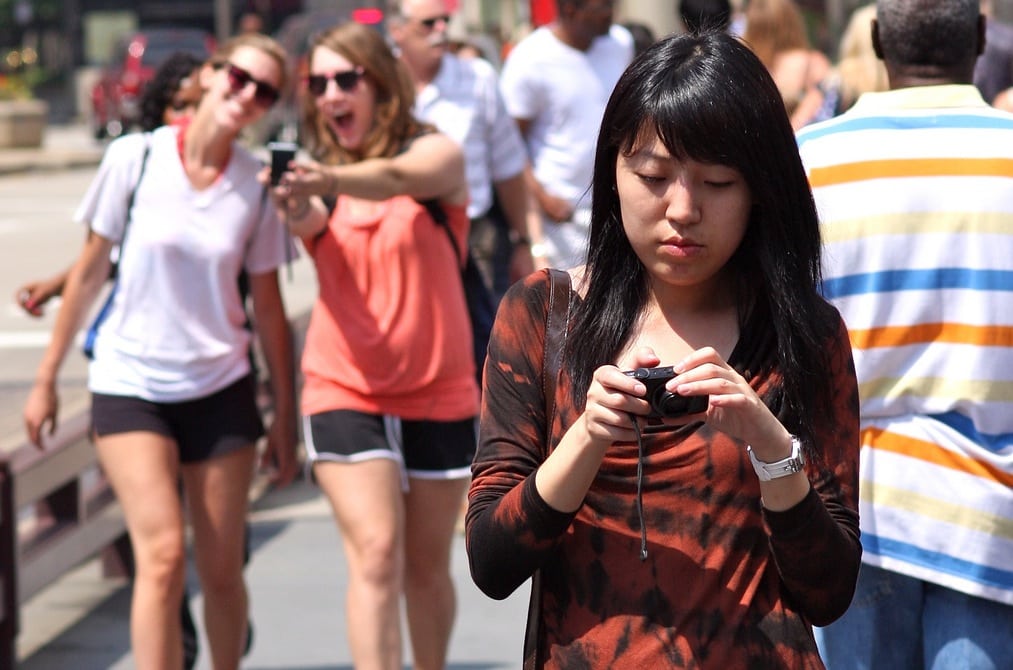Skift Take
Chicago is one of the most congested cities in the U.S., and giving pedestrians, including tourists, and bicyclists a reprieve from the traffic sounds like a worthwhile experiment.
People began walking diagonally through a busy downtown Chicago intersection Friday, part of an experiment to provide extra breathing room between vehicles and pedestrians.
The changes center on a new pedestrian crossing pattern, dubbed the “pedestrian scramble,” that was introduced at the intersection of State Street and Jackson Boulevard.
The goals include giving pedestrians a head start crossing streets and therefore reducing conflicts between pedestrians and turning vehicles, officials said.
The test involves stopping all vehicles — heading east on Jackson and north and south on State — for 35 seconds every third traffic light cycle to let pedestrians cross in all directions, including diagonally.
The test got underway at 10:17 a.m., and some pedestrians cheered and hooted in celebration as they crossed at State and Jackson. Still, there was some skepticism of how the experiment will go, at least at first.
“How many ambulances will be here today?” asked pedestrian Beverly Hadley, 57, a paralegal who works downtown. “People will get confused. My concern is the drivers more than the people crossing. I know it works well on paper and in Europe, so we’ll just have to see.”
The State and Jackson intersection averages about 41,600 pedestrians and 20,500 vehicles on a typical weekday, according to the Chicago Department of Transportation.
The experiment will last several months and, based on results, could become permanent at that location.
Chicago Transportation Commissioner Gabe Klein said today that traffic at the intersection “will flow better, not worse. We think we can make all modes [of transportation] safer.”
Klein said “it’s actually fun to cross the street diagonally.”
Developed more than 70 years ago, the pedestrian scramble concept allows pedestrians a running start to cross six ways instead of four ways.
The experiment is part of a larger plan by Klein to reduce speeds and the number of vehicle travel lanes on busy streets in an effort to slash the number of crashes.
About 3,000 vehicle crashes involving pedestrians, causing several dozen pedestrian deaths, occur in Chicago each year, according to the Illinois Department of Transportation. The city’s pedestrian plan calls for reducing crash-related pedestrian injuries by 50 percent.
Klein’s strategy involves narrowing some streets, or putting them on a “road diet.”
On other streets, dedicated bicycle lanes and buses-only lanes for future bus rapid transit service will be added. Klein has said he believes that multiple modes of transportation coupled with slower speeds overall will yield safer streets.
Under Klein, who formerly headed the transportation department in Washington, D.C., CDOT traffic engineers also plan to reduce the number of corners downtown where drivers can turn right on red, while increasing the opportunity for pedestrians — particularly at high-accident locations — to enter crosswalks unchallenged before the traffic signal for vehicles turns green, officials said.
Many drivers may not be keen on the idea of reducing vehicle capacity in one of the most congested cities in the United States. But Klein appears to have strong support from Mayor Rahm Emanuel.
Twitter: @jhilkevitch ___
![]()
The Daily Newsletter
Our daily coverage of the global travel industry. Written by editors and analysts from across Skift’s brands.
Have a confidential tip for Skift? Get in touch
Tags: chicago, quality of life
Photo credit: Pedestrians in Chicago are getting a break as the city experiments in giving them a headstart and making cars wait awhile at busy intersections. Kevin Dooley / flickr.com
